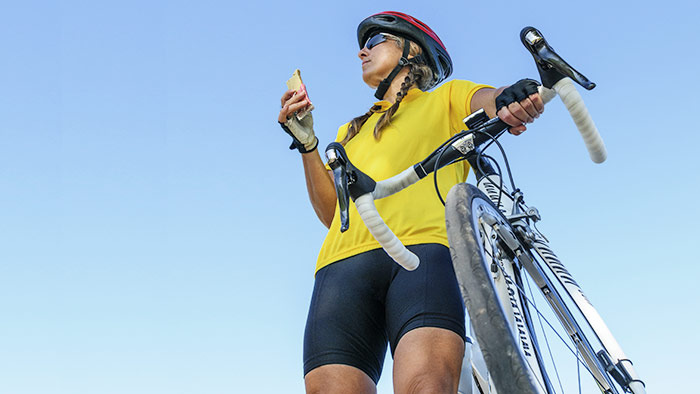The majority of triathletes and runners are always striving to be leaner and reach their fastest “race weight,” both within the season and in the off-season. It is absolutely true that the leaner you are, the faster you can run and bike—at least to a point. But eating too few calories can have the opposite effect athletes are shooting for.
Vanderburgh (2006), who created the Flyer Handicap scale, estimates that an athlete can run approximately 20 seconds per mile faster with every 10 pounds lost —and the athlete will see more time gained the further the running distance.
An athlete might also be able to push higher watts per kilogram on the bike, especially advantageous on those pesky hills, with a lower body weight. So, it’s no wonder triathletes and runners are striving to be leaner.
However, not having enough calories to support your training can increase body fat retention and muscle loss. When the body does not know when it will be fed again, it will start conserving energy. To do this, metabolism slows, fat preservation starts, and the body will start getting rid of calorie-demanding muscle tissue.
Fat, an energy dense source, will be the last thing the body wants to get rid of in a calorie-restricted state. This can cause an ugly cycle of restricting calories because of an athlete feeling overweight, then gaining weight because the athlete is not eating enough, then restricting calories more.
This can lead to the Relative Energy Deficit in Sports (RED-S), which can diminish performance, affect immunity along with menstrual function and bone health, and be tied to overtraining syndrome since the body cannot recover, while leading to long term health problems (Eberle, 2015).
Not eating enough is more common than you would probably guess, both among underweight athletes and overweight athletes. I’ve spent eight years working as a personal fitness trainer and nutrition coach, reviewing countless food logs, and the most common issue I found, especially among my female clients, has been not eating enough. Clients would often be well under 1,200 calories.
But these were general fitness clients, triathletes are much better at fueling their bodies, right? Well, not so much. Again, most common among females, I see athletes training 10 to 15 hours per week and barely hitting 1,200 calories per day. This is well below what your body needs just to sustain your everyday activities—let alone to fuel your training.
The general guideline for weight loss for female runners is 1,200 to 1,500 calories per day, and 1,500 to 1,800 calories per day for men, but these ranges are higher for triathletes who are averaging 12 to 15 hours of training per week ( and even more for IRONMAN athletes in the peak volume of their training cycle). Generally, a safe amount to lose is between .5-.75 lb per week.
Below is a sample day of a 130 lb female who completed a 90-minute workout in the morning, and is targeting a race weight of 125 lbs. The following diet would give her a calorie deficit of between 300 to 500 calories with her daily activities. This assumes she has a Resting Metabolic Rate (RMR) of about 1,350 calories and burned 700 calories in her workout.
- Preworkout – Granola bar, Juice (~250 calories)
- 90 min workout
- Breakfast – Oatmeal, handful of walnuts, banana (~350 calories)
- Snack – Greek yogurt with cinnamon, berries, and chia seeds (~250 calories)
- Lunch – Tuna and spinach on whole wheat bread with carrots and hummus on the side (~400 calories)
- Snack – Apple with peanut butter (~300 calories)
- Dinner – Chicken breast, sweet potato, broccoli (~400 calories)
Total = 1850 calories
If you are someone who is not sure they are eating enough, try logging your food for a week on Myfitnesspal or Livestrong/Myplate (both free), and see how many calories you are reaching each day.
I do not encourage logging food and calorie counting forever, which can become very tedious, but logging for a week or two can be a good check on total calories along with your breakdown of macronutrients (carbs, fats, and protein).
After you monitor your intake for a week or so, try using your body’s cues and start listening and respecting your body better. Your body is a wise machine and will let you know how much you need to eat—if you’re willing to listen.
Nutrition is the fourth discipline in triathlon, and if you are not getting it right, you will not be successful in executing the swim, bike and run both in training and on race day. You train too hard to ruin your training adaptations and race results with nutrition errors. Fuel that training so you can be your best and achieve those big dreams!
References
Eberle, S.G. (2015, June 15). Nutritional Value: Relative Energy Deficiency in sports. Retrieved from https://coachad.com/articles/relative-energy-deficiency-in-sports/
Vanderburgh, P.M. & Laubach, L.L. (2006). Validation of a 5k Age and Weight Run Handicap Model. Retrieved from https://ecommons.udayton.edu/cgi/viewcontent.cgi?article=1034&context=hss_fac_pub



